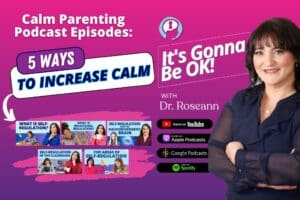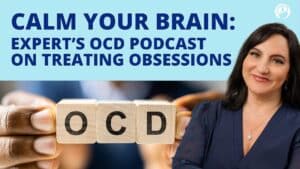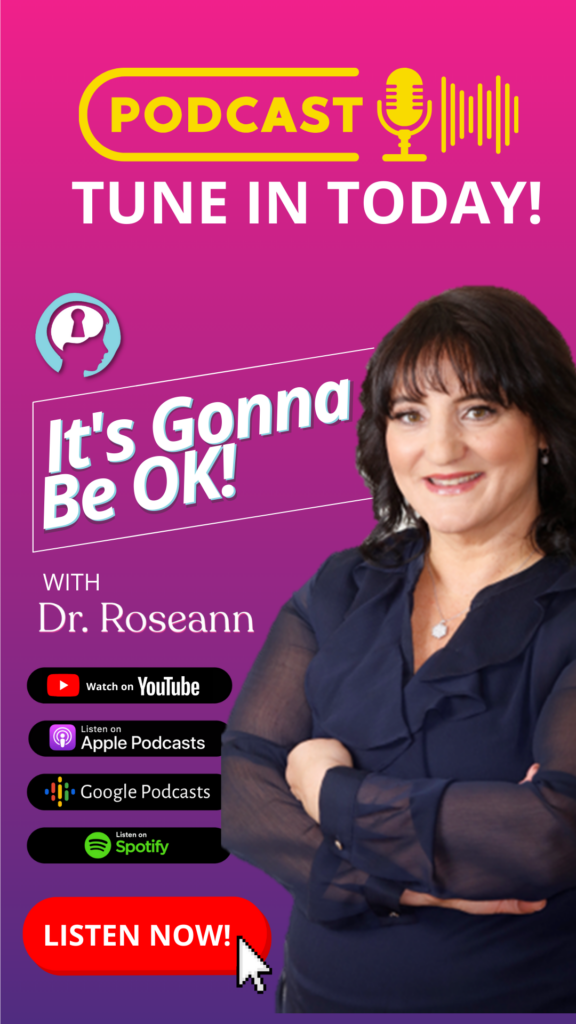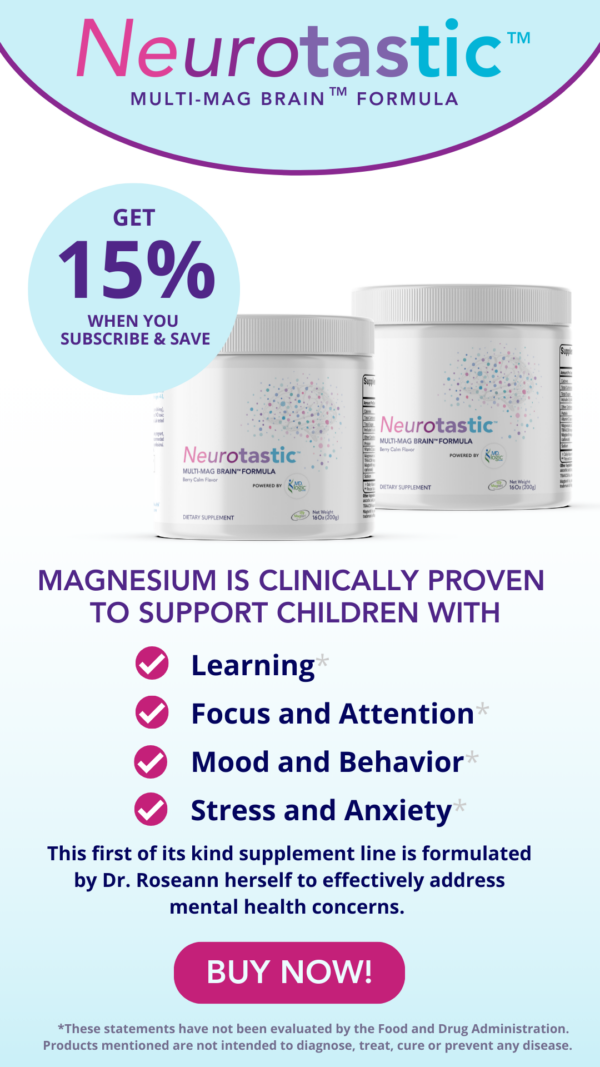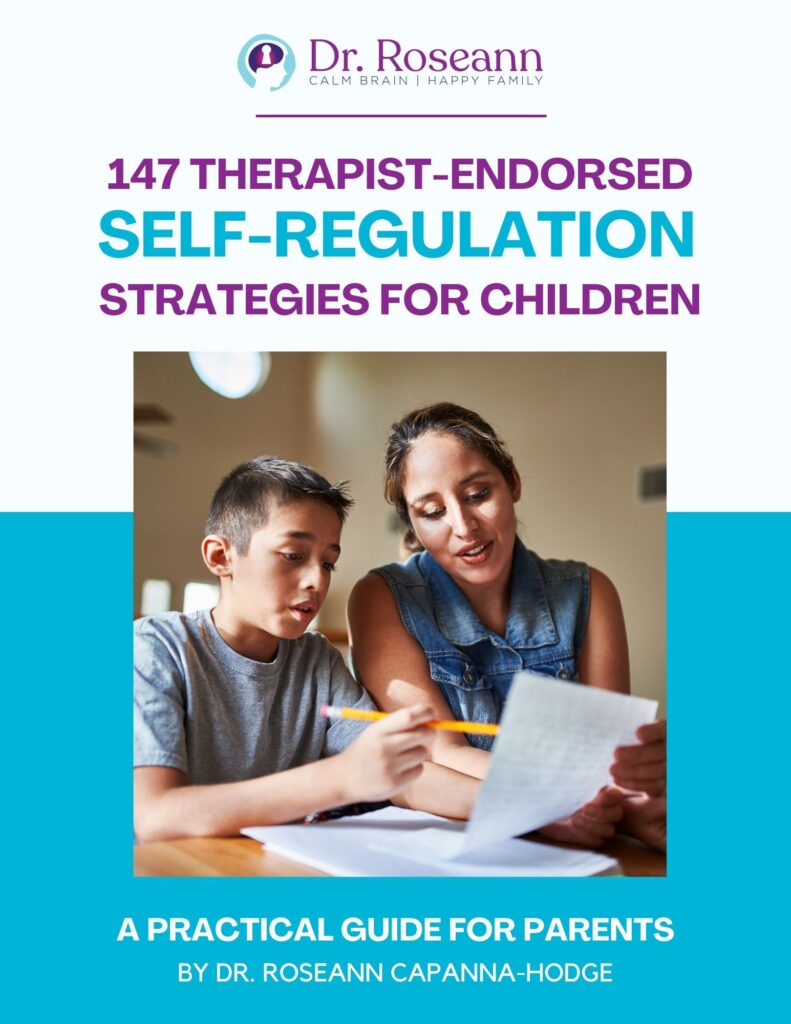I have a PANS/PANDAS child and as a parent watching your child struggle with this disease, saying that you feel overwhelmed each day is an understatement. My son and I went through a labyrinth of symptoms that ranged from sudden obsessions and compulsions to mood swings and debilitating anxiety.
With all my expertise in mental health, these symptoms have left me feeling utterly helpless too. So for over three decades, I've walked alongside countless families with problems the same as mine, guiding them through the maze of this disease.
Just remember that amidst the chaos, there's hope for healing. There are treatments available for PANS/PANDAS in children and teens, which I’d like to share with you. IVIG treatments or, the Intravenous Immunoglobulin treatment is one of those treatments that can calm a brain on fire.
What is IVIG Treatment?
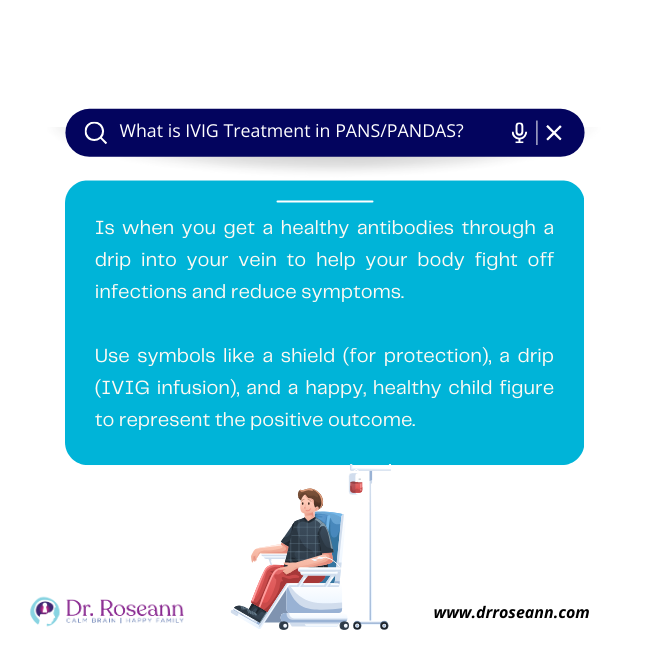
Imagine IVIG as an army of tiny immune defenders coursing through your child's veins. These defenders, also known as Immunoglobulins, are purified antibodies collected from the plasma of thousands of blood donors. When administered intravenously, they bolster your child's immune system and help it distinguish the good stuff from the bad stuff inside the body while restoring balance.
Let me share a story that illustrates the transformative power of this IV treatment. Sarah, a bright-eyed 9-year-old, had been engulfed by the storm of PANS. Her days were consumed by debilitating rituals and paralyzing anxiety. After multiple failed treatments, her parents were on the brink of despair.
However, upon starting IVIG infusions, a remarkable shift occurred. Not long after, Sarah's symptoms began to recede. Her laughter returned, her eyes sparkled with newfound joy, and hope bloomed once more in her parents' hearts. Thankfully, IVIG worked for her but that isn’t always the case with every case.
How Does Intravenous Immunoglobulin Work for PANS/PANDAS?
IVIG works specifically in PANS/PANDAS by targeting autoantibodies and modulating the immune response that leads to neuropsychiatric symptoms. It helps alleviate symptoms such as obsessions, compulsions, mood swings, and anxiety.
One study investigated the treatment of PANS/PANDAS using intravenous immunoglobulin therapy, focusing on 55 extreme-grade symptomatic patients. IVIG treatments given at 2 g/kg per day for two consecutive days resulted in significant symptom improvement or complete remission for 85% of the children, with some requiring a second administration for lasting improvement (Pavone et al., 2020).
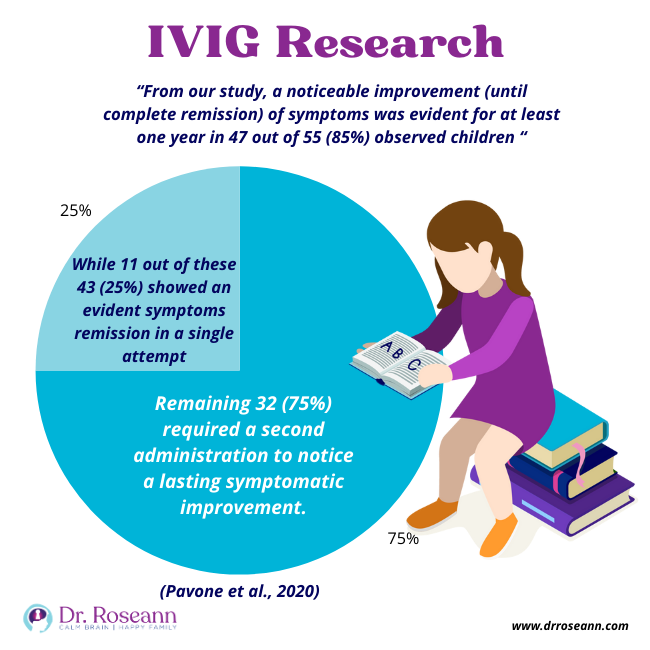
Parent’s Guide to the IVIG Treatment Journey
Embarking on the IVIG journey can feel overwhelming, but let's break down the process into manageable steps. It’s important to work closely with an immunologist throughout the treatment process as they also play a vital role in the management of PANS and PANDAS (Bellanti, 2023).
Understanding IVIG Infusion
IVIG infusion involves the administration of Immunoglobulins directly into a patient's bloodstream via intravenous (IV) access. These antibodies serve as reinforcements for the immune system to help regulate and balance its response. It also contains anti-inflammatory properties to help to quell the immune system's overactive response often seen in conditions like PANS/PANDAS.
Preparing for IVIG
Before IVIG therapy, the healthcare team will conduct a thorough assessment to ensure your child is ready for the treatment. This may involve blood tests, vital sign monitoring, and a review of medical history.
IVIG Infusion Process
When on the IV Immunoglobulin therapy, your child will be comfortably seated or reclined as the IVIG solution is slowly administered through a needle or catheter inserted into a vein. The duration of the infusion can vary depending on factors such as dosage and tolerance. It typically ranges from a few hours to a full day.
Most children with PANS or PANDAS do multiple IVIG treatments: typically 6 to 12 with some individuals needing 20 or more. These treatments are done over one to two days in a single month with a gap of one month before the next treatment.
Monitoring IVIG Side Effects
Throughout the infusion, your child will be closely monitored by healthcare professionals for any side effects of IVIG infusion, including an adverse IVIG reaction. Vital signs such as blood pressure, heart rate, and temperature may be checked regularly to ensure safety and comfort. Your healthcare team will be standing by, equipped with strategies to mitigate any discomfort and ensure a smooth voyage.
Tracking Progress
The monitoring of your child’s Immunoglobulin IV infusion treatment will continue and the healthcare team will check on your child's progress closely. They will be assessing symptom improvement and fine-tuning treatment as needed. Always remember that healing doesn’t occur overnight. Patience is key.
Celebrating Victories
Each milestone, no matter how small, is cause for celebration in the journey of any treatment for PANS/PANDAS. Whether it's a reduction in obsessive thoughts, a newfound sense of calm, or a return to cherished activities, it pays to take a moment to appreciate the slow and hopefully steady progress.
It is important to note that I see with my patients that making lifestyle and dietary changes can help prevent any destabilization from flares.
Other Natural Treatments for PANS/PANDAS
The treatment for PANS/PANDAS in children may be arduous at times. But there are many options and natural treatments generally complement therapy. Parents may also include nutritional support with a focus on anti-inflammatory foods, gut health optimization through probiotics and prebiotics, magnesium supplements, and herbal remedies such as turmeric and ashwagandha to reduce inflammation and support stress management.
Mind-body therapies like mindfulness meditation and yoga can help alleviate anxiety, while environmental modifications such as reducing exposure to toxins and allergens in the home can minimize symptom triggers.
It's essential to work with a qualified healthcare provider, ideally through the BrainBehaviorResetTM Program, to develop an individualized treatment plan that combines natural approaches with conventional therapies for optimal outcomes in children with PANS/PANDAS.
If you want an insider look at what healthcare professionals look for when diagnosing PANS and PANDAS, download the PANS/PANDAS Checklist for Practitioners.
What is Intravenous Immunoglobulin used for?
IVIG is used to treat a variety of immune-related disorders, including primary immunodeficiency diseases, autoimmune conditions, and neurological disorders such as PANS/PANDAS. It works by providing concentrated IVIG doses of antibodies to bolster the immune system and modulate immune responses.
What does IVIG do for children with PANS/PANDAS?
The IV immunoglobulin infusion therapy for children with PANS/PANDAS helps modulate the immune system. This treatment potentially alleviates symptoms associated with PANS/PANDAS such as obsessions, compulsions, mood swings, and anxiety.
How does IVIG work in autoimmune diseases?
IVIG works in autoimmune diseases by providing a high concentration of antibodies derived from pooled human plasma. These antibodies help modulate the immune system, reducing inflammation and suppressing autoimmune responses that target the body's tissues and organs.
How to tell if IVIG is working?
You can tell IVIG is working if you notice a reduction in symptoms associated with the autoimmune or immune-related condition being treated, such as decreased inflammation, improved mobility, or a reduction in disease flares. Additionally, laboratory tests may show changes in markers of inflammation or immune function, indicating a positive response to the treatment.
How long does IVIG take to work?
The timeframe for IVIG to start working can vary among individuals and conditions, but some patients may notice improvements in symptoms within a few days to weeks after treatment. Full therapeutic effects may take several weeks to manifest, with continued monitoring to assess the treatment's effectiveness.
What to expect after IVIG infusion?
After an IVIG infusion, you may experience mild side effects such as headaches, fatigue, or nausea, though these typically resolve on their own. Additionally, you may notice improvements in symptoms related to the autoimmune or immune-related condition being treated, such as reduced inflammation or enhanced immune function, in the days or weeks following the infusion.
How is IVIG made?
IVIG is made from pooled human plasma obtained from thousands of blood donors. The plasma is purified to isolate the antibodies, which are then concentrated and formulated into IVIG products for therapeutic use.
What is in IVIG medications?
IVIG contains a concentrated dose of antibodies obtained from pooled human plasma. These antibodies help modulate the immune system and restore immune balance in conditions such as autoimmune diseases, primary immunodeficiency disorders, and neurological conditions like PANS/PANDAS.
Is IVIG a blood product?
Yes, IVIG is considered a blood product because it is derived from human plasma obtained from blood donors. It contains antibodies that help modulate the immune system and is used to treat various immune-related disorders.
Does IVIG affect blood work?
Yes, IVIG therapy can affect certain blood work parameters, particularly those related to immune function and inflammation. Changes in markers such as white blood cell count, platelet count, and inflammatory markers may be observed following IVIG treatment.
How does IVIG increase platelet count?
IVIG can increase platelet count in conditions such as immune thrombocytopenia (ITP) by modulating the immune system. It is believed to work by blocking the destruction of platelets by autoantibodies and promoting platelet production in the bone marrow.
Is IVIG immunotherapy?
Yes, IVIG can be considered a form of immunotherapy because it involves the administration of antibodies to modulate the immune system. IVIG therapy is used to treat various immune-related conditions, including autoimmune diseases.
Is IVIG chemotherapy?
No, IVIG is not chemotherapy. IVIG therapy involves the administration of antibodies derived from pooled human plasma to modulate the immune system, whereas chemotherapy refers to the use of drugs to treat cancer by destroying cancer cells or inhibiting their growth.
How long does IVIG stay in your system?
IVIG typically stays in the body for about 3 to 4 weeks after infusion, with the antibodies gradually being broken down and eliminated. However, the duration of IVIG's effects can vary depending on factors such as the individual's metabolism, the dosage administered, and the specific condition being treated.
How to administer IVIG therapy?
IVIG is administered intravenously, typically through a needle or catheter inserted into a vein. The infusion is delivered slowly for several hours, under the supervision of healthcare professionals in a clinical setting.
How to give IVIG immunoglobulin transfusion?
IVIG immunoglobulin transfusion is administered intravenously through a needle or catheter inserted into a vein. The infusion is delivered slowly over several hours, typically in a clinical setting under the supervision of healthcare professionals.
How long does IVIG infusion take?
The duration of IVIG infusion can vary depending on factors such as dosage, infusion rate, and individual tolerance, but it typically lasts several hours. Infusions may range from a few hours to a full day, with healthcare professionals monitoring the process closely for safety and efficacy.
Does immunoglobulin therapy work?
Yes, immunoglobulin therapy can be effective in treating various immune-related disorders by providing a concentrated dose of antibodies to modulate the immune system. It has been shown to alleviate symptoms and improve outcomes in certain neurological conditions.
How long does IVIG take to work in myasthenia gravis?
The timeframe for IVIG to work in myasthenia gravis can vary among individuals, but some patients may experience improvement in symptoms within a few days to weeks after treatment. Full therapeutic effects may take several weeks to manifest, with continued monitoring to assess the treatment's effectiveness.
How many liquid IVS can I have a day?
The recommended intake of liquid IV or any similar hydration product depends on individual hydration needs and tolerance. It's generally advisable to follow the manufacturer's instructions and consult with a healthcare professional for personalized guidance on fluid intake.
Is IVIG an immunosuppressant?
IVIG is not typically considered an immunosuppressant. Instead, it modulates the immune system by providing a concentrated dose of antibodies to restore immune balance and alleviate symptoms in conditions such as autoimmune diseases and immune deficiencies.
What's IVIG infiltration?
IVIG infiltration refers to the unintended leakage of IVIG solution into the surrounding tissues during infusion, instead of being delivered into the bloodstream through the intravenous catheter as intended. It can lead to swelling, discomfort, and potential tissue damage at the infusion site.
What is an IVIG treatment dose for kids?
The IVIG treatment dosage for kids varies depending on factors such as the child's weight, medical condition, and treatment goals. Dosages typically range from 1 to 2 grams per kilogram of body weight, administered over several hours in each infusion session.
How much is IVIG treatment?
The cost of IVIG treatment can vary widely depending on factors such as the dosage, frequency of infusions, and individual healthcare provider or facility charges. On average, IVIG treatment can range from several thousand to tens of thousands of dollars per infusion session.
Can you get IVIG while on antibiotics?
Yes, it is possible to receive IVIG therapy while on antibiotics, as long as there are no contraindications or interactions between the medications. Your healthcare provider will assess your specific situation and determine the appropriate course of treatment.
How long does IVIG treatment last?
The duration of IVIG treatment varies depending on the individual's response to therapy, the underlying condition being treated, and the treatment goals. Some patients may require ongoing or periodic IVIG infusions to maintain symptom control and immune balance, while others may experience long-term remission and discontinue treatment after a certain period.
Is IVIG safe?
IVIG therapy is generally considered safe when administered under the supervision of healthcare professionals. However, like any medical treatment, it carries potential risks of side effects and adverse reactions, which should be carefully monitored and managed.
Citations
Bellanti, J. A. (2023). The PANDAS/PANS disorders. Is it time for more allergist-immunologists to get involved? Allergy and Asthma Proceedings, 44(5), 296–305. https://doi.org/10.2500/aap.2023.44.230029
Pavone, P., Falsaperla, R., Cacciaguerra, G., Sapuppo, A., Chiaramonte, R., Lubrano, R., Messina, G., Sciuto, S., Sabino, L., Cocuzza, S., Maniaci, A., Fontana, A., Marino, L., Oliva, C., Pappalardo, M. G., & Vecchio, M. (2020). PANS/PANDAS: Clinical Experience in IVIG Treatment and State of the Art in Rehabilitation Approaches. NeuroSci, 1(2), 75–84. https://doi.org/10.3390/neurosci1020007
Dr. Roseann is a mental health expert in PANS/PANDAS who frequently is in the media:
- Healthy Parenting Connector (Video) Why “My Kid is Acting Crazy” Might be PANS/PANDAS
- Living with Lyme (Podcast) Neurofeedback and biofeedback for PANS/PANDA
- Maria Rickert Hong (Audio) PANS/PANDAS
Dr. Roseann is a Children’s Mental Health Expert and Licensed Therapist who has been featured in/on hundreds of media outlets including The Mel Robbins Show, CBS, NBC, PIX11 NYC, Today, FORBES, CNN, The New York Times, The Washington Post, Business Insider, Women’s Day, Healthline, CNET, Parade Magazine and PARENTS. FORBES called her, “A thought leader in children’s mental health.”

She coined the terms, “Re-entry panic syndrome” and “eco-anxiety” and is a frequent contributor to media on mental health.
Dr. Roseann Capanna-Hodge has three decades of experience in working with children, teens and their families with attention-deficit hyperactivity disorder (ADHD), autism, concussion, dyslexia and learning disability, anxiety, Obsessive Compulsive Disorder (OCD), depression and mood disorder, Lyme Disease, and PANS/PANDAS using science-backed natural mental health solutions such as supplements, magnesium, nutrition, QEEG Brain maps, neurofeedback, PEMF, psychotherapy and other non-medication approaches.
She is the author of three bestselling books, It’s Gonna Be OK!: Proven Ways to Improve Your Child's Mental Health, The Teletherapy Toolkit, and Brain Under Attack. Dr. Roseann is known for offering a message of hope through science-endorsed methods that promote a calm brain.
Her trademarked BrainBehaviorResetⓇ Program and It’s Gonna be OK!Ⓡ Podcast has been a cornerstone for thousands of parents facing mental health, behavioral or neurodevelopmental challenges.
She is the founder and director of The Global Institute of Children’s Mental Health, Neurotastic™Brain Formulas and Dr. Roseann Capanna-Hodge, LLC. Dr. Roseann is a Board Certified Neurofeedback (BCN) Practitioner, a Board Member of the Northeast Region Biofeedback Society (NRBS), Certified Integrative Mental Health Professional (CIMHP) and an Amen Clinic Certified Brain Health Coach. She is also a member of The International Lyme Disease and Associated Disease Society (ILADS), The American Psychological Association (APA), Anxiety and Depression Association of America (ADAA) National Association of School Psychologists (NASP), International OCD Foundation (IOCDF).
© Roseann-Capanna-Hodge, LLC 2024




